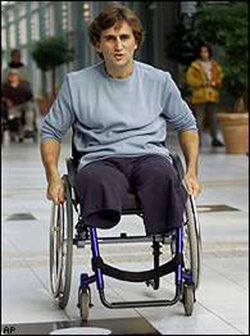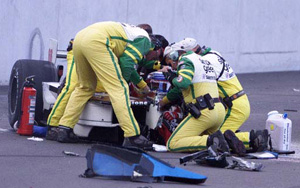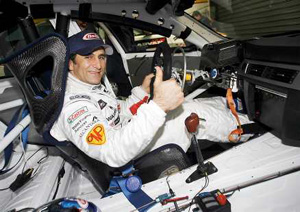What makes a sports “hero?”
The term “hero” is used quite a bit when referring to athletes, but are athletes really “heroic?”
 There are a few performances in sports legend that certainly are worthy of consideration… We’re reminded of Willis Reed in the 1970 NBA championship who, despite a painful injury, entered game seven just long enough to get his team fully inspired towards victory. Another classic moment was a severely hobbled Kirk Gibson stepping in against the most dominant pitcher in baseball (Dennis Eckersley) in game one of the 1988 World Series and crushing perhaps the most unlikely home run ever. How about Lance Armstrong continuing winning at bike racing despite his fight with cancer, or Floyd Landis who (testosterone enhanced or not) won the Tour de France on a badly damaged hip? There was Terrell Owens’ gallant, painful, effort in a losing cause in the 2004 Super Bowl, and Ronnie Lott’s willingness to amputate one of his fingers to be able to play in the 1985 Super Bowl… painful, yes… heroic… probably.
There are a few performances in sports legend that certainly are worthy of consideration… We’re reminded of Willis Reed in the 1970 NBA championship who, despite a painful injury, entered game seven just long enough to get his team fully inspired towards victory. Another classic moment was a severely hobbled Kirk Gibson stepping in against the most dominant pitcher in baseball (Dennis Eckersley) in game one of the 1988 World Series and crushing perhaps the most unlikely home run ever. How about Lance Armstrong continuing winning at bike racing despite his fight with cancer, or Floyd Landis who (testosterone enhanced or not) won the Tour de France on a badly damaged hip? There was Terrell Owens’ gallant, painful, effort in a losing cause in the 2004 Super Bowl, and Ronnie Lott’s willingness to amputate one of his fingers to be able to play in the 1985 Super Bowl… painful, yes… heroic… probably.
Sports history is laden with heroic performances in the face of pain and adversity, but we’d like to share a bit about one of our personal heroes here at S2ki… Honda racing legend Alex Zanardi.
Zanardi had reason to fear automobiles. When he was a child, Alex’ beloved sister was killed in an automobile accident cutting short her promising swimming career, yet by the time he was 13, he was racing carts. By age 22, Zanardi was competing and winning in the Italian Formula 3 series. Four years later, he had advanced to the pinnacle of motor sports, Formula One.
Right out of the box, he had trouble. A devastating crash while qualifying for the 1993 Belgian Grand Prix put Zanardi in the hospital and ended his season. Although his recovery would take quite a long time, he wouldn’t let it end his career… Still injured at the beginning of the ’94 F1 season, he was without a ride. An injury to Pedro Lamy gave him a chance to get back behind the wheel, but reliability problems with his Lotus didn’t allow him much success, and by ’95 he no longer had a team willing to employ him.
He didn’t give up…
 Spending most of the ’95 season racing sports cars, Alex continued to look for a sponsor to put him back behind the wheel of a world class race car. Chip Ganassi and CART came calling… the rest is open wheel history. Rookie of the year in ’96 (and perhaps the most famous “pass” in Laguna Seca history) CART Champion for ’97 and ’98, and the originator of the “post race victory burn-out”, Zanardi was a huge fan favorite.
Spending most of the ’95 season racing sports cars, Alex continued to look for a sponsor to put him back behind the wheel of a world class race car. Chip Ganassi and CART came calling… the rest is open wheel history. Rookie of the year in ’96 (and perhaps the most famous “pass” in Laguna Seca history) CART Champion for ’97 and ’98, and the originator of the “post race victory burn-out”, Zanardi was a huge fan favorite.
Bolstered with new confidence… Zanardi returned to F1 in 1999, but his success did not follow him. Although signed for three years, team owner Frank Williams fired Zanardi in 2000 and replaced him with newcomer Jenson Button.
Unfazed, Zanardi returned to Champ Car to pick up where he’d left off. On September 15th 2001, in Brandenburg Germany, at the hastily renamed “American Memorial 500” (it was only four days after 9/11) tragedy met with Zanardi again. Leading the race in the closing laps, Zanardi was re-entering the track following a pit stop. He spun into the path of another car travelling at over 200MPH. When he awoke in his hospital bed, both his legs were gone.
Most auto racers would consider their carrers over with the loss of both legs… not Alex.
 In 2002, he was back at the track waving the checkered flag for the race in Toronto. By 2003, he was back behind the wheel with the aid of hand operated brakes and accelerator. He went back to the track that nearly took his life and turned in a run that would have qualified him fifth for the race that weekend.
In 2002, he was back at the track waving the checkered flag for the race in Toronto. By 2003, he was back behind the wheel with the aid of hand operated brakes and accelerator. He went back to the track that nearly took his life and turned in a run that would have qualified him fifth for the race that weekend.
He was not only back behind the wheel, he was actually competitive!
On August 24th 2005 at the World Touring Car Championship, the comeback had come full circle; Alex Zanardi was back in the winners circle! He celebrated by turning his traditional celebratory donughts which (thanks to him) has become a tradition of American Racing.
Alex has co-written two books about his amazing story: Alex Zanardi: My Story (2004) and Alex Zanardi: My Sweetest Victory (2004).
A race car driver who managed to continue driving and winning without his legs… that’s our idea of a hero.
Discuss this here:
https://www.s2ki.com/forums/index.php?act=ST&f=150&t=413573
